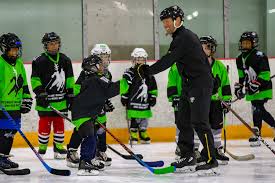What are the boards in hockey called? The “side boards” are the boards along the two long sides of the rink. The half boards are the boards halfway between the goal line and blue line. The sections of the rink located behind each goal are called the “end boards”. The boards that are curved (near the ends of the rink) are called the “corner boards”.
How much do hockey boards cost? The price will depend on your overall size. A good rule of thumb is to plan to spend about $70 per linear foot for the regular ProWall® boards (great for dek hockey, ball hockey, and roller hockey) and $95 per linear foot for ProWall-ICE® (used for outdoor ice hockey).
What are dasher boards in hockey? 1. This is a term that is used to describe the boards of a hockey rink, which are usually made of either steel or aluminum. In addition, the dasher boards are used as a defensive method of clearing the puck out of their team’s zone or to help execute a pass.
What material are hockey boards made of? HDPE (High-density polyethylene) is the most common plastic sheet available today. It is a thermoplastic known for its strength to density ratio. Generic HDPE sheet is commonly known as Puck Board, as it has been the material of choice in hockey arenas for many years.
What are the boards in hockey called? – Additional Questions
Why are the bottom of hockey boards yellow?
RINK SURROUNDS
The kickplate at the bottom of the boards is light yellow. The boards are constructed so that the surface facing the ice is smooth and free of any obstruction or any object that could cause injury to players.
Why do hockey fans hit the glass?
This actually happened in the NHL back in December when a fan at an Avs game banged on the glass next to the Oilers’ penalty box. The reason why an item like a ring easily shatters glass is because glass that is tempered or toughened is considered to be a state of stress.
What is the plastic on hockey boards?
HDPE is the material of choice for dasher boards because of its high impact strength, durability, smooth finish, moisture resistance, and low maintenance requirements. Its extreme resilience to impact in colder temperature makes it the ideal, logical choice for ice hockey rinks.
What is HDPE board?
HDPE (High Density Polyethylene) is a material commonly used in cutting boards and other food services applications. Its excellent durability and low moisture absorption make it a logical choice for these applications.
Is HDPE a plastic?
But high-density polyethylene (or HDPE) plastic has been courting my favor recently. Not only is it one of the most versatile of plastics—used in everything from hard hats to house wraps—it’s also widely recycled, in both its rigid form (e.g., containers) and flexible form (e.g., bags).
Can you skate on HDPE?
Regular metal-bladed ice skates can be used or either recreational use or training. The two standard forms of synthetic ice are HDPE or High Density Polyethylene and UHMWPE or Ultra High Molecular Weight Polyethylene. Both surfaces have abrasive-resistant characteristics and are available in many forms and sizes.
Is it harder to skate on synthetic ice?
Synthetic ice isn’t as smooth as real ice and therefore is more resistant against skate blades (friction). So this means that it takes a little more effort than skating on a real ice surface. The benefit is that it makes you work harder to skate and that will translate into an easier experience on real ice.
Can you skate on fake ice?
You can use any kind of ice skates on synthetic ice.
The only difference is that you will have to sharpen your skates a little more often as skating on a synthetic surface tends to dull the blade more than conventional ice.
Does synthetic ice wear out?
If you opt for the Swiss premium quality of Glice®, synthetic ice lasts up to 30 years, easily trumping conventional ice and other synthetic ice products.
Can synthetic ice ruin your blades?
Taking Care of Your Skate Blades
While skating on synthetic ice won’t damage your skates any more than natural ice, it’s important to take good care of your skates regardless of what surface you’re training on.
Can you skate on synthetic ice in the winter?
There is no need to worry about fluctuating temperatures when installing a synthetic outdoor rink. Figure skaters, hockey players and recreational skaters will all enjoy year-round skating.
How do you maintain synthetic ice?
Synthetic Ice Maintenance at Home
For smaller surfaces used at home probably the most common form of cleaning your synthetic ice is the old mop and bucket method. A good wet mop will loosen up the dirt. Put a liberal amount of water on the surface and then wring out the mop and use it again to remove the dirty water.
What do you spray on synthetic ice?
EZ Glide Enhancer™
EZ Glide Enhancer is a non-toxic, non-staining spray-on glide enhancer developed by Ice Rink Engineering and Manufacturing, LLC for use on all synthetic ice surfaces, including self-lubricating and oil infused panels once their lubrication has dissipated.
Is synthetic ice slippery to walk on?
Just remember to back it out when you want to skate and remember that although synthetic ice isn’t as slick as actual ice, it is still slippery. When you walk to or from your car, treat it like real ice to avoid falls!
How do you clean a synthetic ice rink?
Can you put synthetic ice on grass?
Though Syn-Ice panels can be placed directly on a grass surface, to ensure a quality Syn-Ice rink it is recommended one has a solid, flat and level surface. If a grass surface is preferred, we recommend a sub-floor or a vapor barrier to protect the panels for which we can provide assistance.
Do synthetic ice tiles work?






